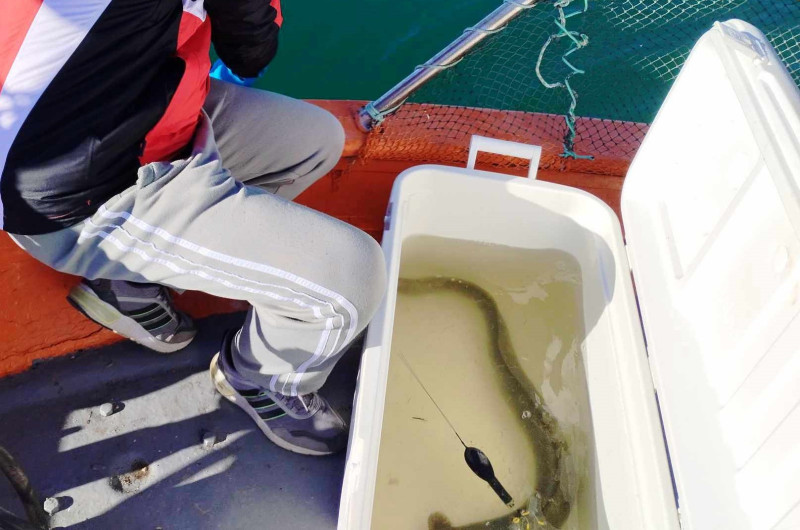The 12 eels will make an impressive transatlantic journey of 8,000 km with the final destination being the Sargasso Sea, in the Caribbean
Another journey of a lifetime with the final destination of the Sargasso Sea, in Caribbeanstarted a few days ago for a group of eelstwelve of which have a state-of-the-art GPS device on them.
THE release of eels from the lake Vistonida was made in the framework of the Lifeel program (https://lifeel.eu/el/) and is implemented by IN.A.L.E. (Fisheries Research Institute based in Nea Peramos, Kavala).
Since the beginning of the program in mid-December, around 340 eels have been released to date. Most of them have been marked with a plastic ID (with a number and the website of the program), while the last twelve were marked with the state-of-the-art mechanism of a GPS.
During the program, the researchers of IN.A.L.E. together with their colleagues from Italy, who are also participating in this project, will study this unique life journey of the eels, which now constitute protected species due to overfishing and climate change.
An impressive transatlantic journey of 8,000 km.
“This is an impressive transatlantic journey of 8,000 km”, underlines the ichthyologist of IN.ALE. and scientific manager of the project Dr. Argyris Sapunidis. “It’s a journey of a lifetime for the eels,” he continues, “that their instincts will lead them to the warmer waters where they will give birth and die. If everything goes well (there is no catching them and predation by seals and sharks) then the eels are expected to reach their final destination, in the Sargasso Sea, after sixteen to eighteen months.”
The attempt to record the course followed by the silver eel species in Aegean and then to Mediterraneanis predicted to yield significant data about the route which follow, the speed with which they swim, as well as the depth in which they move during the day and night. It should be noted that eels travel at depths ranging from 200 to 1000 meters.
When the transmitter is released from the eel
“The total of twelve eels that were released from Lake Vistonida carry on their backs a special GPS satellite device connected to the global ARGOS system, which collects the data transmitted by the transmitter”, notes Mr. Sapunidis with emphasis and underlines that “it is for a highly sophisticated device costing as much as $4,800 each, plus shipping and customs clearance. These satellite devices are battery operated. After an interval eight – ten monthswhich will soon have reached Gibraltar, the battery of the device runs out and then the device is released from the back of the silver eel and rises to the surface of the sea. It is the moment when the device starts to broadcast by satellite all the data it recorded and stored during this period of travel of the eels”.
The processing of the data is as impressive a process as the journey of the eels, since the satellite devices will transmit to the central server located in France and then the data will be transferred to the US to be decrypted. Mr. Sapunidis estimates that in about a year they will have all the information at their disposal. As for the first eels tagged with the plastic ID, they can only be traced if someone catches them at some point in their journey, locates the ID, and contacts the program with information.
The research team
In the last release of the eels, the contribution of the fishing cooperative of Vistonida was important, which made the eels available for tagging. The action lasted three days, when the eels were released into the Bay of Biston after first measuring their total length, their fin length, their diameter, the diameter of their eye and their weight.
The research team consisted of Drs. Argyri Sapunidis, Dr. Manos Koutraki, Fotis Arapoglou, Voula Papadopoulou from IN.AL.E. and Dr Kim Aarestrup from the Danish National Institute for Marine Research.
One of the most expensive catches in the world
The eel is currently one of the most expensive catches, mainly in the Asian markets. In the European Union, however, it is a species of protected wild fauna, which is threatened with extinction, as the eel does not reproduce in captivity and the overfishing of its offspring has resulted in the reduction of its population by 90%.
Its export from the E.U. has been banned, while within the EU states its movement is allowed, as at the beginning of Spring it begins the long journey to the Sargasso Sea in order to give birth.
The larvae return to Europe, where in the rivers of France, Spain, Portugal, Italy and Greece glass eels are produced in the months of November to March and their fishing, although illegal, takes place mainly on moonlit nights. In various ways, the sandpapers go out of the E.U. destined for the Asian markets and mainly Hong Kong where their price can reach up to 1,500 euros per kilo.
Source: Skai
I have worked as a journalist for over 10 years, and my work has been featured on many different news websites. I am also an author, and my work has been published in several books. I specialize in opinion writing, and I often write about current events and controversial topics. I am a very well-rounded writer, and I have a lot of experience in different areas of journalism. I am a very hard worker, and I am always willing to put in the extra effort to get the job done.












